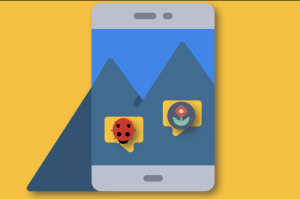Three Studies on Augmented Reality
 Children’s Augmented Storying in, with and for Nature
Children’s Augmented Storying in, with and for Nature
Drawing on a relational ontology and scholarship of new literacies, we investigate the materiality and performativity of children’s augmented storying in nature. Our study is situated in a Finnish primary school in which a novel, augmented reality application (MyAR Julle) was utilized as a digital storytelling tool for children (n = 62, aged 7-9), allowing them to explore, interact, and imagine in nature and to create/share their stories. The data corpus consists of their narrations of their augmented stories in nature, their augmented story artefacts, and video/observational data from their construction of such stories in nature. Narrative analysis reveals how the children’s augmented storying in nature was performed through playful, affective, and sensuous, identity, cultural, and critical literacies, which were imaginatively constructed into being at the nexus of their sensed reality and fantasy. These literacies make visible human-material-spatial-temporal assemblages during which the children played with/through the augmented character Julle, felt and sensed with/through Julle, and re-storied their experiences, cultural knowledge, and identities with/through Julle. They also engaged in critical thinking with/through Julle. The study contributes to knowledge on the meaning of materiality in children’s storying in, with, and for nature and the educational possibilities of augmented storying for children’s (eco)literacies.
Teacher Training for ‘Augmented Reading’: The Living Book Approach and Initial Results
Living Book–Augmenting Reading for Life, a three-year EU-funded Erasmus + project (September 2016-August 2019), exploited the affordances of augmented reality (AR) and other emerging technologies in order to address the underachievement of European youth in reading skills. The program developed an innovative approach that empowers teachers from upper primary and lower secondary schools (ages 9-15) to ‘augment’ students’ reading experiences through combining offline activities promoting reading literacy with online experiences of books’ ‘virtual augmentation’ and with social dynamics. Various professional learning activities were designed within the project, aimed at strengthening European teachers’ profile and competences in effectively integrating the Living Book approach into their classroom activities, and in dealing with diversified groups of learners, particularly pupils from disadvantaged backgrounds. Teachers also received training in how to involve parents, and particularly those from disadvantaged and/or migrant backgrounds, in proreading activities to back the overall Living Book strategy at home. The current article provides an overview of the main phases of the Living Book project implementation, and of the program’s key activities and outputs. It also outlines the content and structure of the ‘Augmented Teacher’ and ‘Augmented Parent-Trainer’ training courses developed within the project. Finally, it reports on the main insights gained from the pilot testing of the courses and the follow-up classroom experimentation that took place in the project partner countries.
Augmented Reality in Higher Education: An Evaluation Program in Initial Teacher Training
One of the emerging technologies that have sparked greater interest in pedagogical contexts is augmented reality. This paper aims to assess the impact, practices and attitudes that are generated from augmented reality in the initial training of future teachers, and the presence of these practices in a university training context. The study was carried out with 87 trainee primary teachers. Information was obtained by applying the Wilcoxon test. The qualitative data obtained in open questions were also triangulated. It is emphasized that students do not habitually use this resource at the university, and that with these practices there is sometimes a certain amount of distraction, and even of time being wasted. From the data analyzed, we also highlight that once the availability of resources, class planning and initial teacher training are overcome, augmented reality provides benefits and advantages centered on pedagogies that allow for greater enthusiasm on the part of the students, with significant advantages in creativity, innovation, participation, and especially in the motivation of participants. Coinciding with recent research, our results underline the need for initial training so as to be able to design and apply practices with augmented reality in teaching, and to take advantage of the aforementioned benefits.







